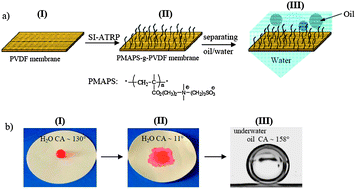A novel zwitterionic polyelectrolyte grafted PVDF membrane for thoroughly separating oil from water with ultrahigh efficiency
Abstract
Oil–water separation is a worldwide challenge because of increasingly oily wastewater, as well as frequent oil spill accidents. We report in this work the fabrication of a zwitterionic polyelectrolyte brush (poly(3-(N-2-methacryloxyethyl-N,N-dimethyl) ammonatopropanesultone), abbreviated as PMAPS)-grafted poly(vinylidene fluoride) (PMAPS-g-PVDF) membrane via a surface-initiated atom transfer


 Please wait while we load your content...
Please wait while we load your content...